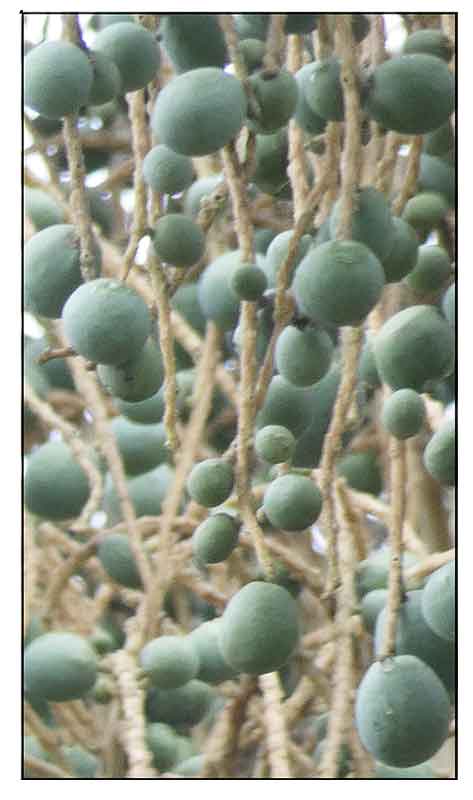 Gen info Gen info
-
Corypha is a genus of palms in the family Arecaceae. The trees are relatively slow growing, taking many years to form a trunk, and only flowers towards the end of its lifetime, at which time it sends up a massive inflorescence up to 5 meters high, with up to one million flowers.
- Talipot palm is a flowering plant with the largest inflorescence in the world. The palm is monocarpic, flowering only once, when it is 30 to 80 years old, taking about a year for the fruit to mature, producing thousands of round, yellow-green single-seeded fruits, 3-4 cm in diameter, and dying shortly after fruiting.
- Historically, leaves were written upon in various Asian cultures using an iron stylus to create palm leaf manuscripts. (3) Buddhist monks have translated old Burmese scriptures, often written on palm leaves of C. umbraculifera. (4)
- Etymology: The genus name Corypha derives from Greek koryphe, meaning 'summit or top', while the species epithet umbraculifera means 'shade-bearing', referring to the umbrella shape and function of the inflorescence.
- Taxonomy and nomenclature conflicts: Some sites publish Corypha utan and C. umbraculifera as synonyms, while as many publish them as separate species. My search and study suggests they are separate species, and as such, are published separately as Buri and Talipot palm. (G.Stuart)
Botany
Talipot palm is a fan palm, one of the largest palms with some reaching heights of up to 25 meters with stems up to 1.3 meters in diameters. Leaves and large and palmate, up to 5 meters in diameters, petiole up to 4 meters, with up to 130 leaflets. Inflorescence is the largest of any plant, 6 to 8 meters (20-26 feet) long, consisting of one to several million small flowers, borne on a branched stalk forming at the top of the trunk (the titan arum). Palm is monocarpic, flowering once, at about 30 to 80 years of age. Fruit takes about a year to mature, producing thousands of round, yellow-green fruit, 3 to 4 centimeters in diameters, each containing a single seed. The palm dies shortly after fruiting. (3)
 Distribution Distribution
- Introduced.
- Cultivated.
- Native to eastern and southern India and Srik Lanka.
- Also grown in Cambodia, Myanmar, China, Thailand and the Andaman Islands.
Parts used
Fruits, stems, roots.
Uses
Edibility
- Sap of inflorescence can be used for making sugar.
- Ripe fruit endosperm is inedible.
- Immature seed endosperm can be made into a sweetmeat. Full ripe endosperm cannot be eaten.
- Trunk yields an edible starch that can be made into flour and used for making bread.
Folkloric
- No reported folkloric medicinal use in the Philippines.
-
In Maharashtra, India, young fruits used as insect repellent. (7)
- Root juice used for treating diarrhea. Decoction of young stems used for treatment of rheumatism. (8)
- Juice from fruit bearing shoots is used for inducing vomiting in persons delirious and giddy from snake bites. It is believed that the same juice can induce abortion.
(9)
Others
- Temple tree: Grown as a temple tree in India, Sri Lanka, China.
- Rituals: Leaves used by traditional healers and soothsayers. The talapat (talipot fan) is used by monks as a ceremonial fan. (3)
- Buddhist scriptures: Traditional Buddhist scriptures were all written on special palm leaves made from Talipot palm, written in ancient Dai. After simple processing, cutting, modifying, drying, and pressing, the leaves were bound into volumes. Iron pens were used to carve ancient Dai into it. (11)
- Crafts: Mature leaves remain flexible for a long period and can be used for making thatches, mats, fans, and hats. Petioles used in making canes, arrows, and netting needles. (3) Hard seeds used for making beads, buttons and ornaments. Fruit globules used for making bracelets and necklaces. (8)(9)
- Wine: Sap tapped from the tree can be used to make a wine.
- Insect repellent: Fruit used for plant derived-nanoparticle-based biopesticide. (6)
- Others: Pounded young fruit used to stupefy fish.
S tudies tudies
• Effect of Thermal Pretreatment on Phosphorylation of Stem Pith Starch: Talipot starch is a non-conventional starch source with high yield (76%) from stem pith of the talipot palm. Study evaluated the effect of three different thermal treatments (dry-heat, heat-moisture, and autoclave treatments) prior to phosphorylation. Thermal pretreatment significantly changed granule morphology. Among all modified starches, dry-heat pretreated phosphorylated starch gel showed improved light transmittance value of 28.4%, indicating reduced retrogradation tendency. Autoclave treatment showed highest resistant starch content of 48.08%. (5)
• Properties and Digestibility: Study evaluated the physicochemical, functional, morphological, thermal, pastiing, and rheological properties of flour and starch obtained from Talipot palm. The palm starch contains high amount of amylose (28.05%). The starch showed a mixture of round, elongated and elliptical shaped granules. Starch and four exhibited A-type crystallinity, and showed no significant difference (p≤0.05) in functional properties. The palm starch showed higher value in pasting parameters and higher enthalpy of gelatinization compared to the flour. (10)
Availability
Cultivated.
|

![]()



 Gen info
Gen info
 tudies
tudies 